Fusion AoIP Mixing Console Overview {LEGACY PRODUCT}
Since 2003, Axia® is the name broadcasters think of first when they think of networked broadcast facilities. Thousands of radio and audio professionals have made Axia their first choice for powerful, flexible, easy-to-use mixing consoles.
Fusion is the Axia modular console packed with features and capabilities refined from over a decade’s worth of IP-Audio experience. It’s available in frame sizes to support consoles up to 40 faders in single or multiple linked frames. Fusion is powered by the Axia PowerStation® or StudioEngine DSP mixing engines, which means it is now 100% AES67-compliant. It connects to the Axia network with a single CAT-6 Ethernet cable, allowing the sharing of local audio devices (and their associated GPIO control) among multiple studios to maximize efficiency and reduce cost.
Axia IP-Tablet Virtual Radio Software
IP-Tablet virtual radio software is one-of-a-kind suite that's a bold step toward the virtual radio studio. It lessens the need for studio monitors by virtualizing the monitoring and control of your Fusion Console or other Telos Alliance gear on a Windows tablet running any of the IP-Tablet Virtual Radio software modules. Sold individually, you can buy those software modules that are most relevant and beneficial to your studio setup, such as the Telos Systems VX or VX Prime phone systems, the Telos Z/IP ONE IP-audio codec, the Omnia.9 audio processor and Omnia VOCO 8 mic processor, xNode, and Axia Pathfinder. IP-Tablet can also now control third-party HTML5-enabled gear. This is Fusion console control, right at your fingertips!
Fusion AoIP Mixing Console Features {LEGACY PRODUCT}
-
Up to 40 fader channels, each with instant, unlimited access to any source. Assign any type of source to any channel.
-
Rugged construction of extruded aluminum ensures rigidity and EM-tightness. Anodized aluminum work surface with laser-etched markings that can’t be rubbed off ensures durability and good looks for life.
-
Four main stereo outputs (Program-1 through Program- 4), plus four stereo Aux sends and two Aux returns.
-
High-resolution OLED displays above each fader strip display selected source, full-time source and backfeed confidence metering, talkback status, pan/fade information and more.
-
Integrated intercom capability includes built-in IFB for two-way communication to individual talent positions via headphone feeds and mics, plus a variety of optional drop-in intercom modules that connect to Axia IP Intercom whole-plant intercom systems.
-
Flexible, intuitive Talkback system lets board ops talk to hosts, studio guests, external feeds — any source with an associated backfeed.
-
Every channel has a stereo Preview (“cue”) function, with a unique latching interlock system for fast, intuitive operation. Multiple channels may be assigned to Preview simultaneously.
-
Reconfigurable monitor section with reassignable controls let operators instantly change monitored sources “on-the-fly.”
-
Software control of options such as EQ, mic dynamics, aux sends and returns, pan and balance and other features delivers maximum flexibility without panel clutter or intimidating controls.
-
Built-in Omnia dynamics processing lets operators combine compression, de-essing and expansion with EQ to “sweeten” microphone sources.
-
A unique, flexible Record Mode enables one-button setup of record mixes for phone bits or off-air interviews.
-
Consolidated user display conveys meter, clock, timer and monitor source information at a single glance. Meter up to 6 buses at once by default, using VU or PPM-style ballistics — add another 4 meters for a total of 10 if desired.
-
Precision timer and clock functions, including an event timer that can be triggered by pre-defined sources, a countdown timer with last-minute alerting and a time-of-day clock that can be synchronized to network time using NTP.
-
Show Profiles set-save-recall feature allows users to instantly recall a customized personal profile, or a profile tailored to specific show types. Up to 99 Show Profiles can be saved for interview shows, music-intensive programming, call-in talk shows, etc.
-
Console functions can be accessed remotely for configuration, management and diagnostic purposes using any standard Web browser.
-
Optional Telos phone control module provides direct, on-the-console line switching control of any Telos multi-line broadcast phone system.
-
Numeric keypad (with # and * keys) lets operators quickly place calls with phone systems or codecs attached to the Axia network.
-
Completely automatic, hands-free mix-minus generation for every Phone caller or remote Codec source.
-
Built-in User Keys for can be programmed with Axia PathfinderPC routing control software to control profanity delay units (such as the 25-Seven® Program Delay Manager), or can be used to trigger routing salvos, scene changes or send GPIO commands.
-
No audio passes directly through the Fusion control surface, keeping your programming safe from studio accidents. All mixing and processing is performed by the StudioEngine or PowerStation mixing engines.
-
Axia’s trademark long-life conductive-plastic faders with side-loading actuation defy dirt, grit and dust.
-
Aircraft-grade switches with LED lighting have been tested to withstand millions of operations.
-
Can be directly remote-controlled using Axia SoftSurface software for Windows.
- Automixer available on all channels.
Fusion AoIP Mixing Console In Depth {LEGACY PRODUCT}

A decade of IP-Audio experience, packed into a single console.
Ask broadcasters who’s the leader in IP-Audio, and chances are good they’ll tell you “it’s Axia.” That’s because we’re the originators of studio networking for broadcast facilities; we produced our first console in 2002 (back when everyone else was saying “Audio over Ethernet? That’ll never work!”), and we’ve been listening, learning and inventing ever since. That’s why thousands of happy broadcasters worldwide have put Axia consoles to work for them.
Now, we’d like to introduce you to Fusion, the newest modular IP-Audio broadcast console from Axia.
Why did we name it Fusion? According to Webster’s, “fusion” means “joining two or more things together to form a single entity.” And that’s just what we’ve done. We’ve taken everything we’ve learned in the past decade – about talent experiences, on-air mechanics, in-studio workflow and more – and combined those thoughts, ideas and observations into the smoothest, most intuitive, most indestructible networked console yet.
Fusion was created from what you, our clients, have taught us about today’s fast-paced broadcast environment; an environment that interfaces with listeners both on the dial and on the ‘Net. And our talented team (made up of scientists, engineers and even former air talent) built a console that has what it takes to support everything from the mile-a-minute call-in talk shows, to tight music-driven formats, to multi-talent morning shows — or anything else your programming department can imagine.
So, what things did we learn that made their way into Fusion? That “Powerful” doesn’t have to mean “complicated,” for one. You taught us that a broadcast console can have lots of capabilities, and still be easy to use. So our console designers looked at the way broadcasters accomplish complicated things, and figured out ways to make them simpler.
Like mix-minus: Fusion creates mix-minus for every codec and phone caller you put on the air. Automatically. With no extra buttons to push, bus assignments to make, or settings to change. It just happens.
Or, take recording off-air phone bits for later playback. ‘Til now, it meant taking talent and callers from Program buses manually, assigning them to utility buses, manually starting a recorder…and don’t forget creating the mix-minus! Fusion’s one-touch Record Mode does all of that for you, managing bus assignments, creating the mix-minus, recording the conversation, even changing the monitor feed — then putting it all back the way it was when you’ve finished.
Then there’s Fusion’s built-in talent Mic processing that combines with its Show Profile set-save-recall system. Got a jock whose voice needs a little extra sweetening? Build a custom voice-processing mode for them using Omnia compression, limiting and de-essing tools, then save those settings in a personalized profile they can recall anytime they want.
What about reconfiguring the console from producing a music show to handling a live in-studio band performance with multiple mics and DI inputs? In the old days, you’d be pushing dozens of buttons to make new input choices, bus assignments, monitor settings and EQ tweaks. With Fusion, you can do it all with two clicks, bringing up a stored Show Profile snapshot that suits the job at hand.
In fact, Fusion is a power-user’s dream. A unique Expert Source Profile mode lets you build custom audio inputs with completely customized GPIO functions, IFB backfeed and mix-minus, and Monitor and Program Bus assignments — all based on channel On/Off/Preview state. These powerful tools give you complete control of the behavior of audio sources – on a per-show basis – as they enter and leave the console, allowing automation of complex operations and helping operators run easier, more error- free shows.
Mixing capacity? Fusion has 4 Program buses, plus 4 Aux sends and 2 Aux returns, along with 16 five- channel “Virtual Mixers” that let you mix multiple audio inputs using software-controlled virtual faders.
You also told us you value durability. Axia consoles are known for their toughness, and Fusion is no exception. All work surfaces are made of heavy-duty, anodized machined aluminum panels. This ensures that Fusion will shrug off mistreatment by even the toughest jocks — there are no plastic overlays to crack and peel, and no paint to wear off. Fusion’s markings are laser-etched, so they stay legible forever; they literally can’t rub off!
We also put razor-sharp, high-resolution OLED displays on every fader strip. These are readable from nearly every angle, which aids talent during fast-paced show production. These OLEDs also display full-time confidence meters for each assigned source, further ensuring smooth, error-free shows and helping prevent dead air. You’ll find even more information in Fusion’s on-screen metering display, too.
Making the most of modern wide-screen monitor design, Fusion displays six stereo meters by default, making it perfect for main control rooms with multiple active program outputs. Meters are switchable and can display gain in VU, DIN or BBC-style PPM, plus EBU Digital and Nordic scales.
Finally, our designers have made Fusion the easiest Axia console, ever, to set up. Like any other AoIP device, it connects directly to the network via Ethernet, allowing unparalleled flexibility when placing consoles and connecting to mixing engines.
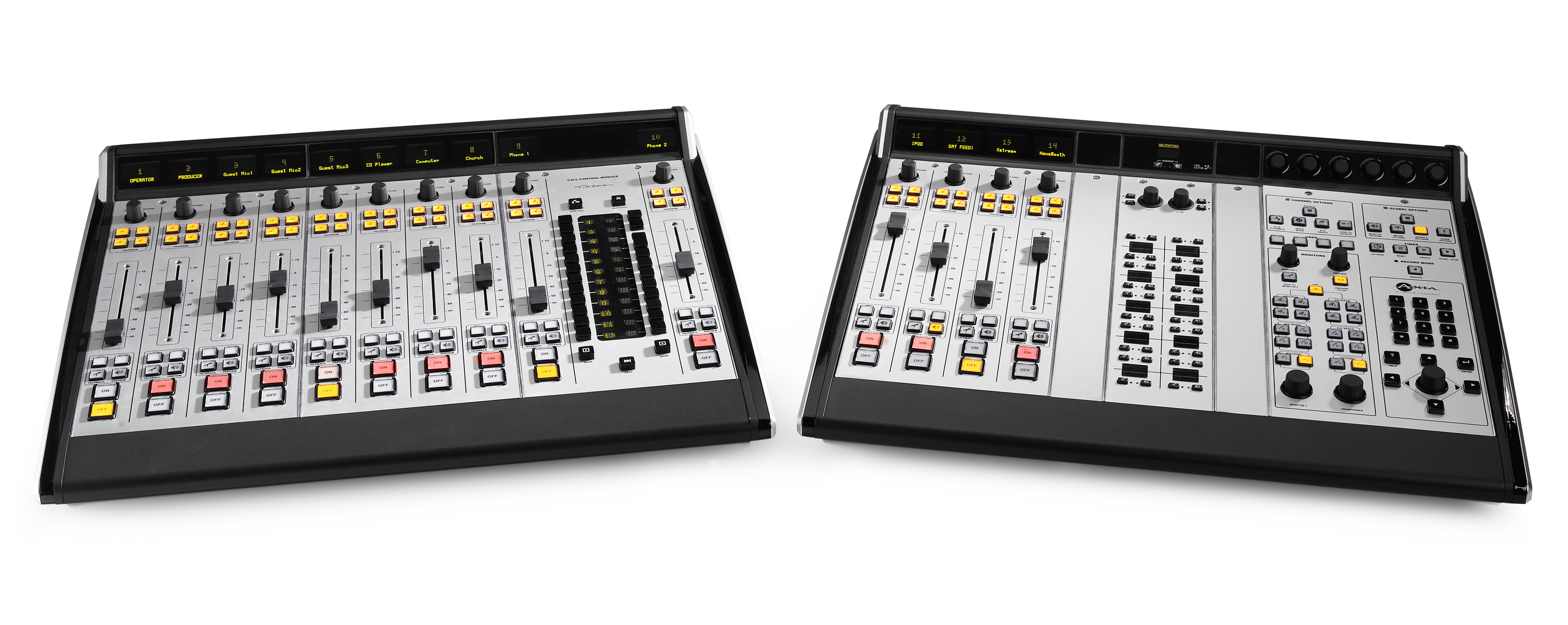 Take a good look at the bottom of a fader strip. Notice there’s a “Talkback” key there? Every mic source on your Axia network – news booth, talent position, producer’s station – can have an individual headphone backfeed. Touching the Talkback key associate with any mic source allows your board op to talk privately to just that talent position (and they can talk back to the CR, too, using their mic). Fusion operators can use even use this unique Talkback feature to communicate with phone callers, remote talent or other studios using the console mic, and can “button mash” to communicate with entire groups of locations at once.
Take a good look at the bottom of a fader strip. Notice there’s a “Talkback” key there? Every mic source on your Axia network – news booth, talent position, producer’s station – can have an individual headphone backfeed. Touching the Talkback key associate with any mic source allows your board op to talk privately to just that talent position (and they can talk back to the CR, too, using their mic). Fusion operators can use even use this unique Talkback feature to communicate with phone callers, remote talent or other studios using the console mic, and can “button mash” to communicate with entire groups of locations at once.
With Fusion, controls for all of your studio devices are right on the console, where they’re most useful. For instance: phone hybrid modules with dedicated faders give instant control of Telos talkshow systems; talent can dial, answer, screen and drop calls without ever taking their eyes off the console, which means smoother, easier on-air phone segments. IP Intercom modules let talent communicate with other places in the broadcast plant using the CR mic, and even take broadcast-quality intercom audio directly to air when desired.
Like all Axia consoles, Fusion has a built-in, password-protected Web server for easy remote administration from your office, your boss’ office, even your home office – anywhere there’s a network connection. Fusion works with Axia SoftSurface virtual console software too, so talent can take direct remote control of the console.
Naturally, our designers put their legendary attention to detail to work on Fusion. Redundant power supply options with fanless convection cooling, hot-swappable modules, silky-smooth conductive- plastic faders with a side-loading design that foils dirt and other contaminants, razor-sharp OLED options displays, optical rotary encoders and, of course, avionics-grade switches with LED lighting (tested to withstand more than five million operations) are all part of Fusion’s premium design. You can also add redundant power without additional IO with Axia Console Power Supply, which offers a single-cable connection to PowerStation Main, providing backup power with automatic switching. (Auto- sensing power supply, 100VAC to 240VAC, 50 Hz to 60 Hz. 250 Watts, 2RU.)
The only thing not premium about Fusion is...its price. For all of this power, flexibility and ease of use, Axia clients have told us they’d expect to pay much more. Luckily, you don’t have to.
Fusion is fully customizable, of course, with a full options list of module types designed to suit your station’s unique way of making great radio. There are integrated controls for phones, codecs and studio talkback, SmartSwitch modules with context-sensitive displays that enable one-touch router salvos, even motorized faders for remote control or integration with your delivery system.
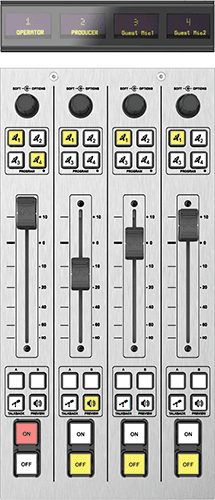 |
4-Fader ModuleThe 4-Fader module is where you start to build your Fusion. Use it for any source: line, mic, hybrid, phone or codec source. Comes in standard and motorized fader versions for use with automation systems or other moving-fader applications. |
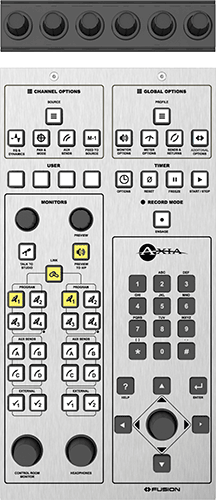 |
Expert Monitor/Navigation moduleThe other basic module you’ll need is a Monitor module. You can choose between two types: The Expert Monitor/Navigation module shown here has extended monitor, headphone and preview controls, a numeric entry/dialpad that can be used with Fusion phone modules, plus four programmable User Keys that can trigger GPIO commands like profanity delay controls or recording devices, or be used with Axia PathfinderPC software to issue routing salvos, initiate scene changes, etc. |
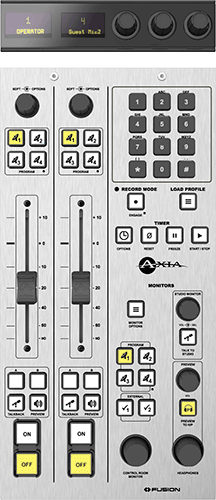 |
Standard Monitor/Navigation ModuleFor studios where expert monitor controls are not needed, the Standard Monitor/Navigation module is a space-saving design that incorporates two faders in addition to the numeric entry/dial pad and basic Monitor/Headphone controls. |
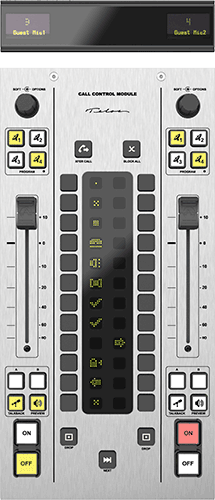 |
Call Controller ModuleThe Call Controller module has two faders plus integrated line switching controls with Status Symbols, for on-console control of advanced Telos broadcast phone systems. Available in standard and motorized-fader versions. |
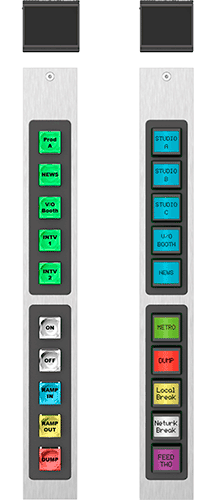 |
Switch ModulesTwo available styles of programmable switch modules work with Axia PathfinderPC routing control tools. They make it easy to put custom routing salvos or simple machine logic right at talent’s fingertips. Economical 10-Button Film-Cap switch modules are perfect for giving talent access to often-used machine-control or GPIO-triggered routing commands. LED button backlights can be individually changed to any of 8 colors. Need more complex control of routing functions? 10-button SmartSwitch modules feature dynamic, backlit LCD displays. Button functions, colors and even text can be programmed to change in response to user input using Axia PathfinderPC software. Construct custom routing salvos, cascading machine-logic command sets, or other complex routing operations. |
|
|
IP Intercom ModulesFusion consoles come equipped with a sophisticated Talkback system that allows board ops to communicate directly with remote talent via individual Talkback channels. But when larger facilities require even more powerful communication capabilities, these intercom modules, part of the Axia IP Intercom system, put broadcast intercom controls right in the console. Station presets and GPIO functions for both types of modules are programmed using any standard Web browser. Using these Intercom modules, Fusion operators can instantly talk to any other studio, control room, operations center – even PCs equipped with Axia SoftCom intercom software. And the audio is broadcast-quality, so putting an Intercom source on-air is easy and sounds great. The 10-Station Filmcap intercom module has 10 LED-lit film-cap buttons for economical on-console IP Intercom integration. |
Fusion User Panels
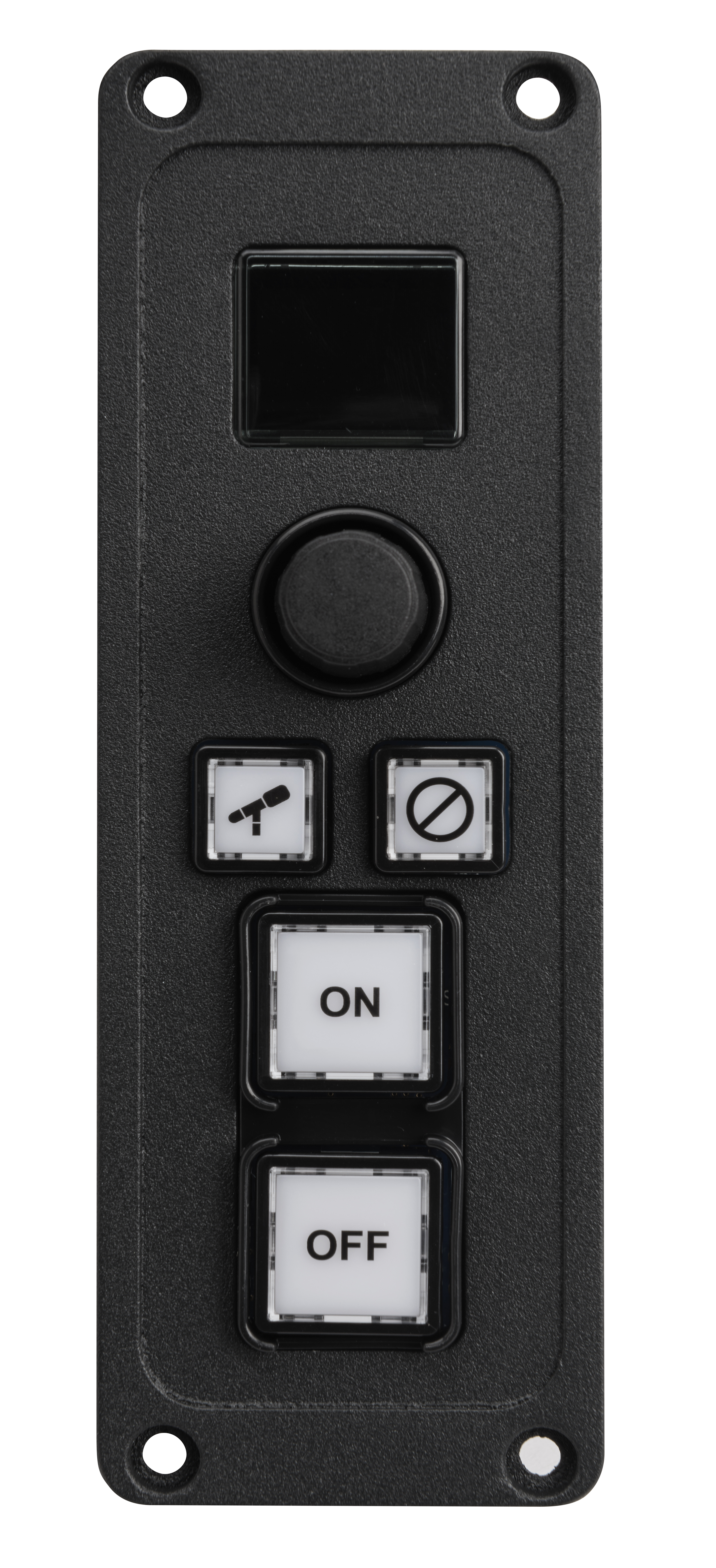 |
Fusion Mic Control / Headphone Selector PanelIn-studio accessory panel mounts in tabletop or turret. Provides remote control of mic on/off functions; dedicated Mute and Talkback buttons give talent full control of their position. Volume/selection knob allows users to select their headphone monitor source; display readout confirms their choice. Connects to Fusion Interface Board CANbus using CAT-5 cable. 6”x 2”, requires 2” mounting depth. |
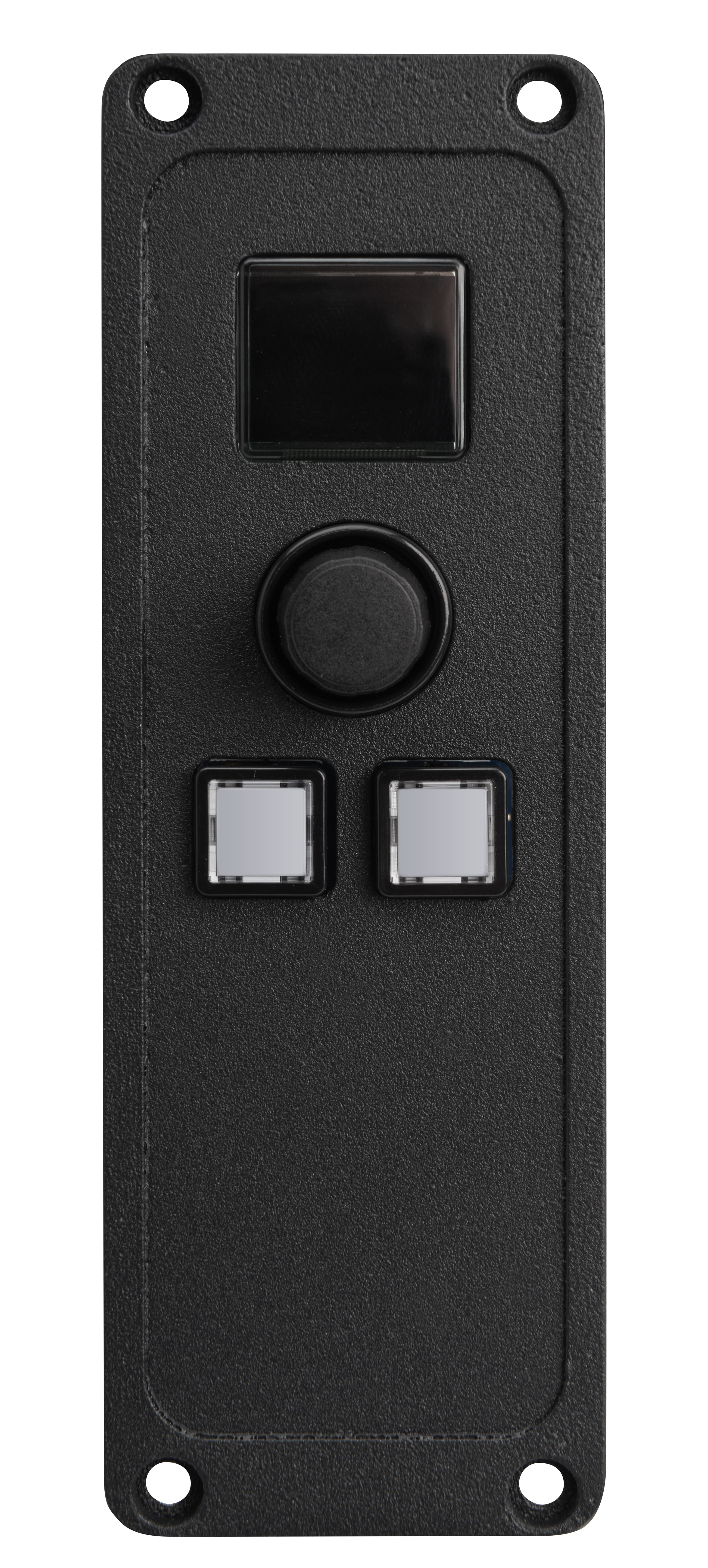 |
Fusion Headphone Selector PanelIn-studio accessory panel with volume/selection knob mounts in tabletop or turret to allow users to select their headphone monitor source; display readout confirms their choice. Two preset buttons let talent quickly recall frequently-listened-to sources. Connects to Fusion Interface Board CANbus using CAT-5 cable. 6”x 2”, requires 2” mounting depth. |
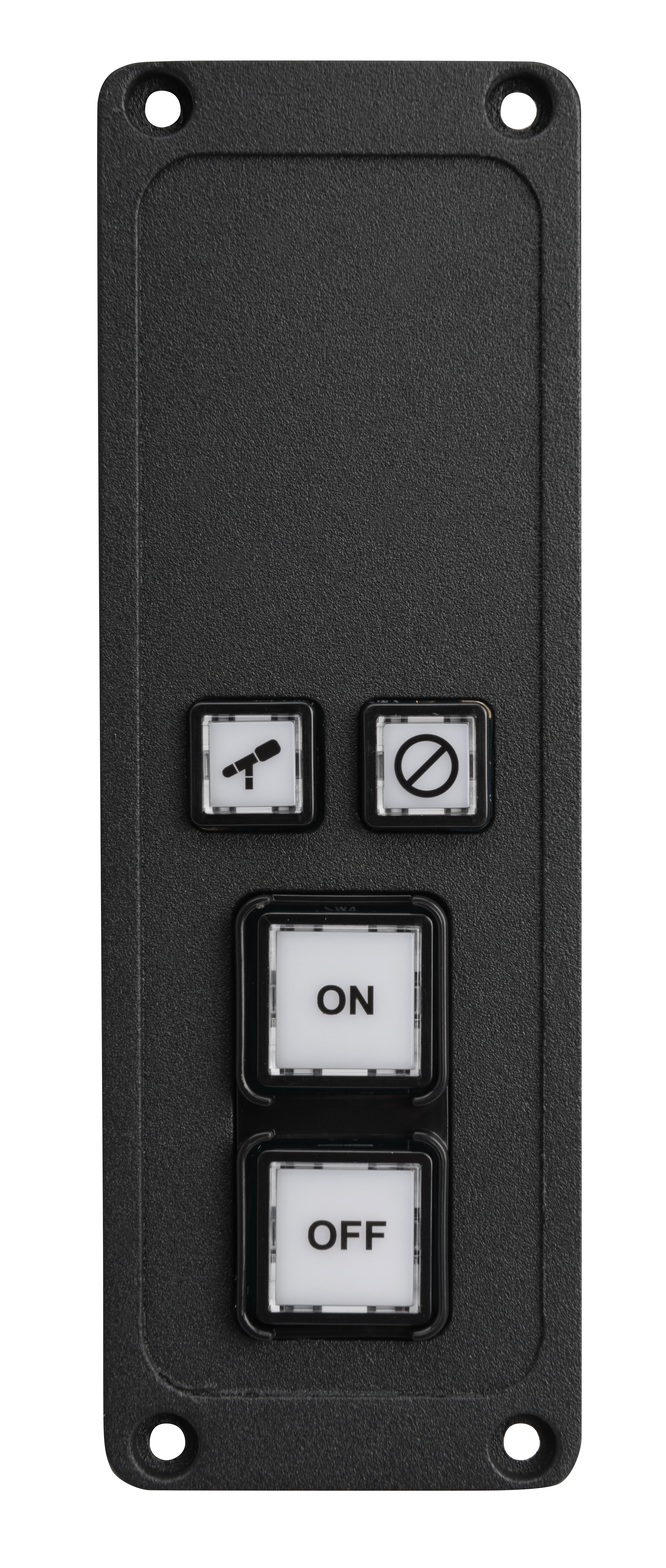 |
Fusion Mic Control PanelIn-studio accessory panel for remote control of mic on/off functions. Mounts in tabletop or turret; includes dedicated Mute and Talkback buttons. Requires one free Axia GPIO port per panel. 6”x 2”, requires 2” mounting depth. |
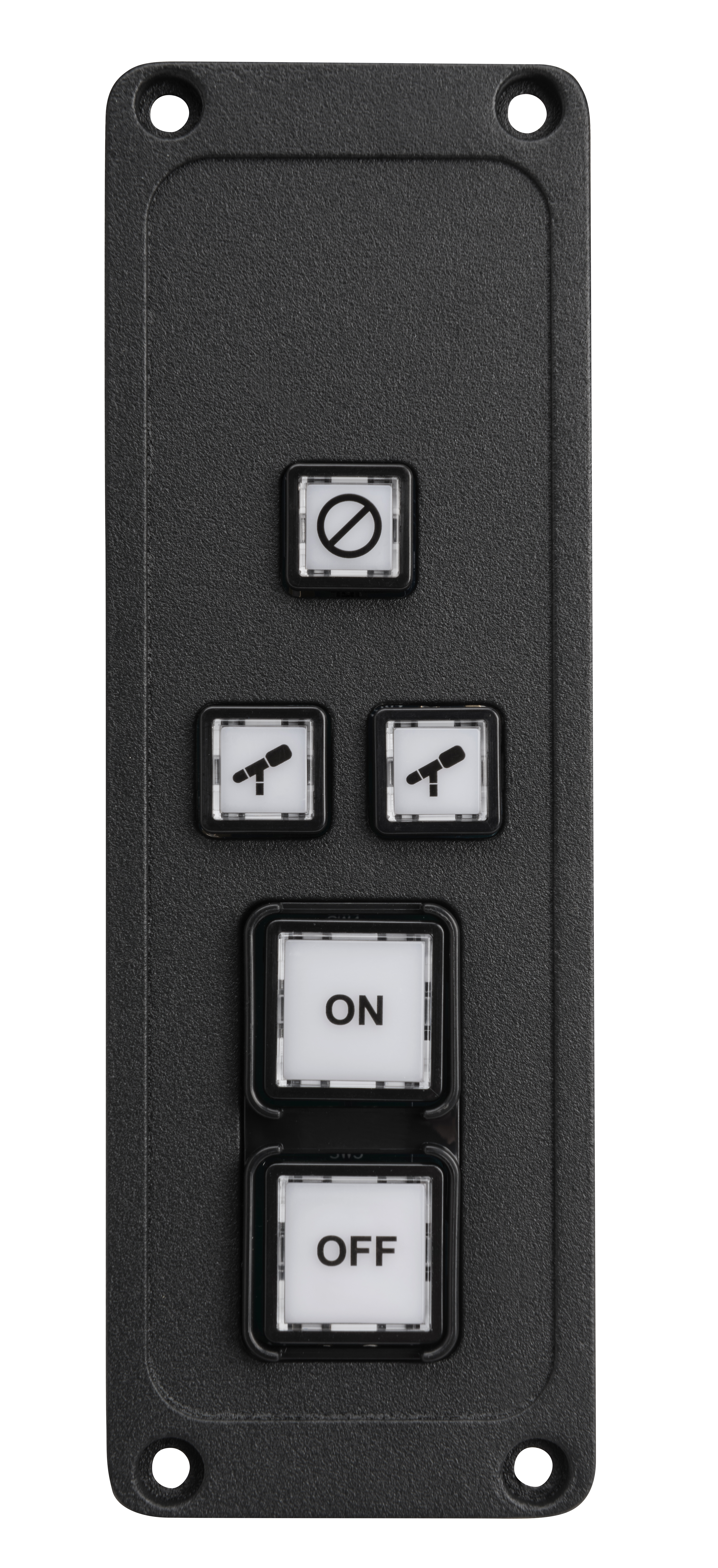 |
Fusion Producer’s Mic Control PanelSpecial accessory panel for producers source profiles, which mounts in tabletop or turret to provide remote control of mic on/off functions. Includes dedicated Mute key. Two Talkback keys allow producers to talk to control room board op, studio guests, or codecs. Requires one free Axia GPIO port per panel. 6”x 2”, requires 2” mounting depth. |
Mixing Engines
Fusion consoles were designed to give you maximum flexibility and configuration options. So instead of just one mixing engine, you’ve got your choice of two! Pair your Fusion control surface with a powerful Linux-based StudioEngine and separate xNode audio interfaces – or choose the PowerStation integrated console engine, an all-in-one powerhouse with audio I/O, DSP mixing engine and integrated zero-configuration network switch.
Studio Engine
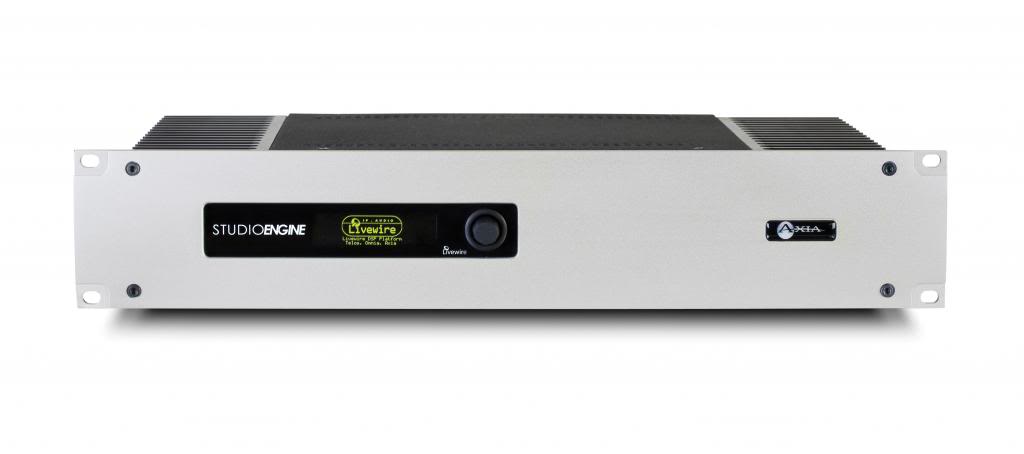 |
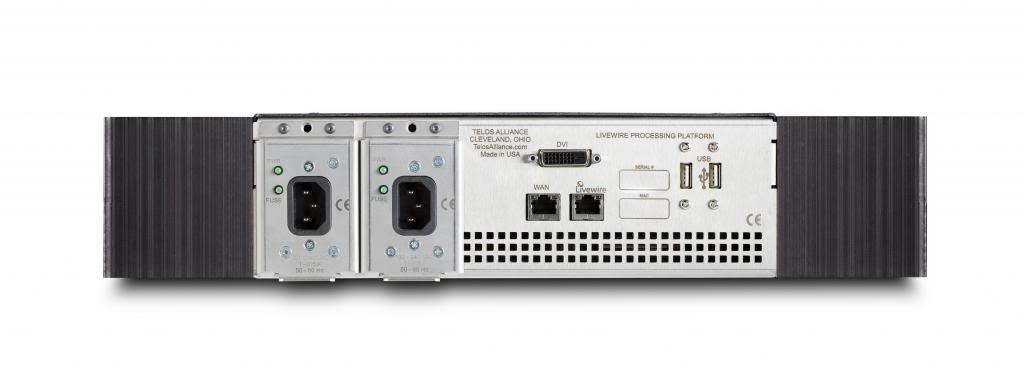 |
Pair your Fusion with Axia StudioEngine, an extremely powerful mixing and processing device based on a blazingly-fast Intel processor. Each StudioEngine is fanless, has dual-redundant field-replaceable modular power supplies, and has so much CPU power it can outperform the very largest digital or router-based consoles. StudioEngine has multiple simultaneous inputs, outputs, mix-minus feeds, monitor signals, EQ and voice processing; it’s the power behind state-of-the-art broadcast studios from New York to Tokyo.
Axia Console Power Supply
 |
 |
If you have chosen an Axia StudioEngine, the Axia Console Power serves as the primary means of power for your Fusion console. Separately, the Power Supply can serve as redundant, auto-switching power supplies for PowerStation, or QOR32 console engines.
The rear of the Axia Power Supply hosts a D-subminiature connector for 48 volts console power, and an EAC connector for AC mains power input. (Auto-sensing power supply, 100VAC to 240VAC, 50 Hz to 60 Hz. 250 Watts. Rackmount, 2RU.)
PowerStation
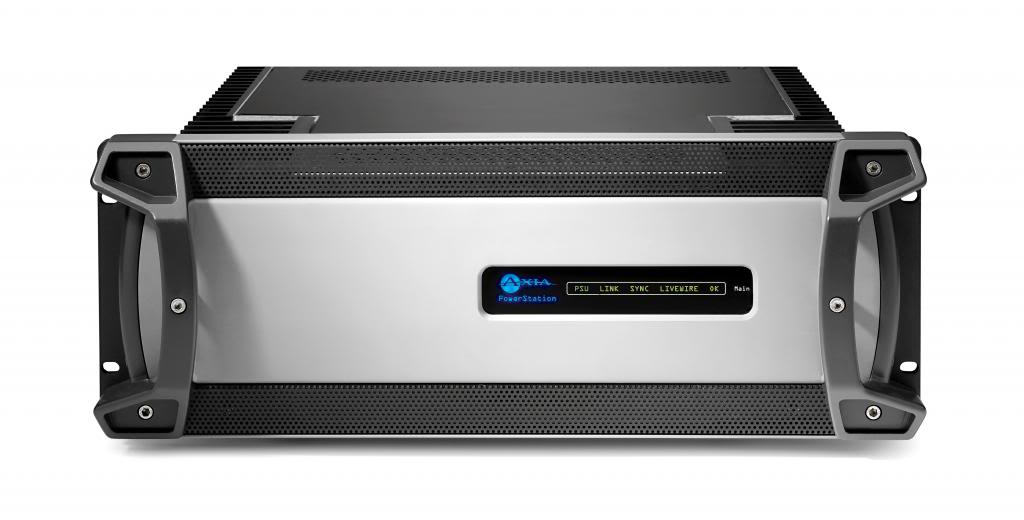 |
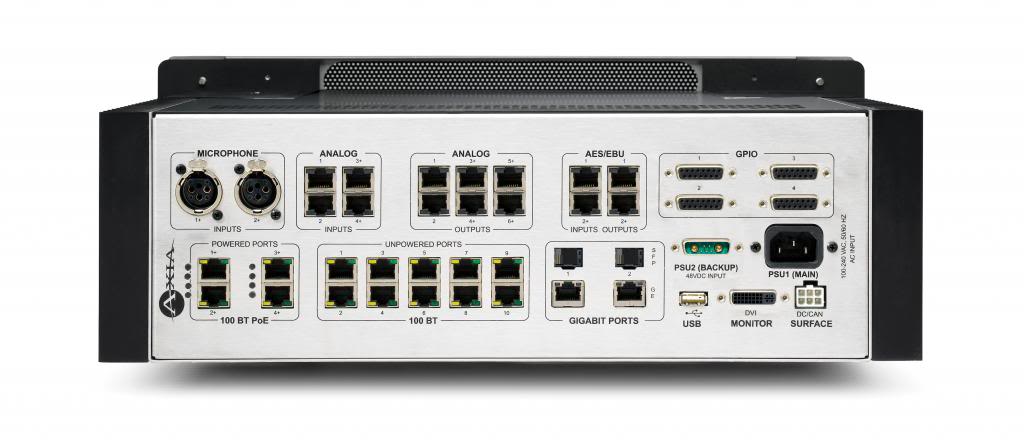 |
PowerStation is an “integrated console engine”, an all-in-one devices that makes it very easy to install Axia studios and Fusion consoles. Inside that ruggedly handsome case you’ll find a super-powered DSP mixing engine, husky power supply sourced from telecom gear designed for harsh environments, plenty of built-in digital, analog and mic I/O, plus EQ, voice processing — and even a custom, built-for- broadcast Ethernet switch with Gigabit connectivity.
PowerStation Aux
 |
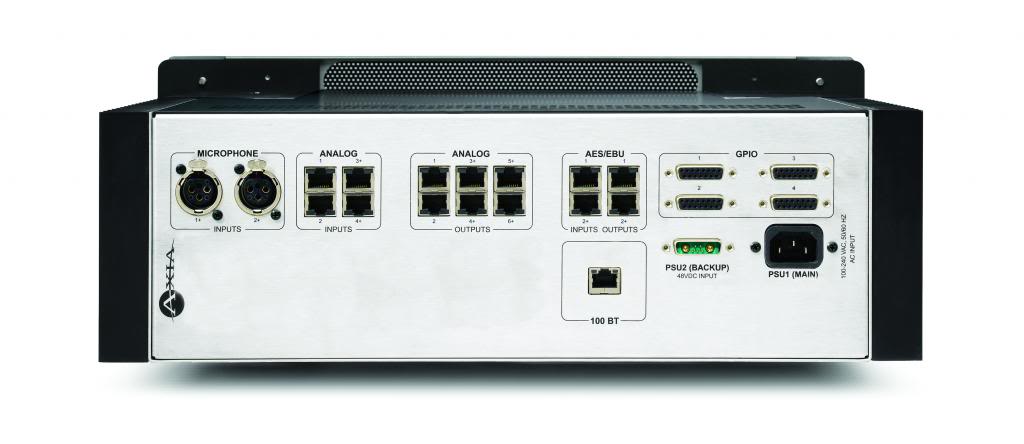 |
To beef up your PowerStation studio even further, there’s PowerStation Aux. Connect it to the PowerStation main to instantly double mic, analog, AES and GPIO ports, and add a redundant backup power supply with auto-switchover.
Most redundant supplies protect only the console, but with PowerStation, the mixing engine, audio I/O and network switch are protected as well.
Fusion AoIP Mixing Console Specifications {LEGACY PRODUCT}
Microphone Preamplifiers
-
Source Impedance: 150 Ohms (Paragraph + Square bullets)
-
Input Impedance: 4 k Ohms minimum, balanced
-
Nominal Level Range: Adjustable, -75 dBu to -20 dBu
-
Input Headroom: >20 dB above nominal input
-
Output Level: +4 dBu, nominal
Analog Line Inputs
-
Input Impedance: >40 k Ohms, balanced
-
Nominal Level Range: Selectable, +4 dBu or -10dBv
-
Input Headroom: 20 dB above nominal input
Analog Line Outputs
-
Output Source Impedance: <50 Ohms balanced
-
Output Load Impedance: 600 Ohms, minimum
-
Nominal Output Level: +4 dBu
-
Maximum Output Level: +24 dBu
Digital Audio Inputs and Outputs
-
Reference Level: +4 dBu (-20 dB FSD)
-
Impedance: 110 Ohms, balanced (XLR)
-
Signal Format: AES-3 (AES/EBU)
-
AES-3 Input Compliance: 24-bit with selectable sample rate conversion, 32 kHz to 96kHz input sample rate capable.
-
AES-3 Output Compliance: 24-bit
-
Digital Reference: Internal (network timebase) or external reference 48 kHz, +/- 2 ppm
-
Internal Sampling Rate: 48 kHz
-
Output Sample Rate: 44.1 kHz or 48 kHz
-
A/D Conversions: 24-bit, Delta-Sigma, 256x oversampling
-
D/A Conversions: 24-bit, Delta-Sigma, 256x oversampling
-
Latency <3 ms, mic in to monitor out, including network and processor loop
Frequency Response
- Any input to any output: +0.5 / -0.5 dB, 20 Hz to 20 kHz
Dynamic Range
-
Analog Input to Analog Output: 102 dB referenced to 0 dBFS, 105 dB “A” weighted to 0 dBFS
-
Analog Input to Digital Output: 105 dB referenced to 0 dBFS
-
Digital Input to Analog Output: 103 dB referenced to 0 dBFS, 106 dB “A” weighted
-
Digital Input to Digital Output: 138 dB
Equivalent Input Noise
- Microphone Preamp: -128 dBu, 150 ohm source, reference -50 dBu input level
Total Harmonic Distortion + Noise
-
Mic Pre Input to Analog Line Output: <0.005%, 1 kHz, -38 dBu input, +18 dBu output
-
Analog Input to Analog Output: <0.008%, 1 kHz, +18 dBu input, +18 dBu output
-
Digital Input to Digital Output: <0.0003%, 1 kHz, -20 dBFS
-
Digital Input to Analog Output: <0.005%, 1 kHz, -6 dBFS input, +18 dBu output
Crosstalk Isolation, Stereo Separation and CMRR
-
Analog Line channel to channel isolation: 90 dB isolation minimum, 20 Hz to 20 kH
-
Microphone channel to channel isolation: 80 dB isolation minimum, 20 Hz to 20 kHz
-
Analog Line Stereo separation: 85 dB isolation minimum, 20Hz to 20 kHz
-
Analog Line Input CMRR: >60 dB, 20 Hz to 20 kHz
-
Microphone Input CMRR: >55 dB, 20 Hz to 20 kHz
Audio Processing
Equalizer
-
Frequency Bands: 20Hz to 320Hz, 125Hz to 2KHz, 1.25KHz to 20KHz.
-
Cut/Boost range on each band: -25dB to +15dB.
-
Q-factor: Automatic - bandwidth varies based on amount of cut or boost.
Compressor
-
Threshold: -30dB to 0dB Ratio: 1:1 to 16:1
-
Post-processor Trim Level: Adjustable from -20dB to +20dB
Expander/Noise Gate
-
Threshold: -50dB to 0dB Ratio: -30dB to 0dB
De-esser
- Threshold: -20dB to 0dB Ratio: 1:1 to 8:1
Axia Console Power Supply
-
Add redundant power to PowerStation main without additional IO.
-
Single-cable connection to PowerStation main provides backup power with automatic switching.
-
Auto-sensing power supply, 100VAC to 240VAC, 50 Hz to 60 Hz.
-
Power consumption: 250 Watts.
Power Supply AC Input, PowerStation Aux & Main
-
Auto-sensing supply, 100VAC to 240VAC, 50 Hz to 60 Hz, IEC receptacle, internal fuse
-
Power consumption: 500 Watts
Operating Temperatures
- -10 degrees C to +40 degrees C, <90% humidity, no condensation
Regulatory
North America: FCC and CE tested and compliant, power supply is UL approved.
Europe: Complies with the European Union Directive 2002/95/EC on the restriction of the use of certain hazardous substances in electrical and electronic equipment (RoHS), as amended by Commission Decisions 2005/618/EC, 2005/717/ EC, 2005/747/EC (RoHS Directive), and WEEE.

























































